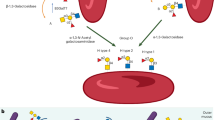Abstract
Maternal humoral immune responses against antigens of the genetically alien embryo have been reported in several mammalian species, including man, although little is known of the biological relevance of this phenomenon. In the mouse, only females of certain inbred strains mated repeatedly with an allogeneic male produce antibody directed against paternally inherited fetal histocompatibility antigens, as assessed by haemagglutination techniques1–4. It has been suggested that this characteristic of the female is associated with the H–2b haplotype3, although some reports indicate that it also extends to other H–2 types5. Potentially deleterious complement-dependent cytotoxicity, albeit at low levels, has been claimed to be associated with this alloantibody, but we have been unable to detect any such activity in a large number of maternal sera6. Four IgG isotypes (IgG1, IgG2a, IgG2b and IgG3) have been identified and shown to occur in the serum of normal animals7,8. Despite their similar physicochemical properties, which complicate purification procedures, the availability of immunoglobulin-secreting plasmacytomas has made possible the preparation of isotype-specific antisera9,10. Using these antisera in a modified haemadsorption assay11, we have now demonstrated that the major alloantibody response induced by murine pregnancy involves the non-complement-fixing IgG1 subclass. This is a noncytotoxic antibody with potentially protective (enhancing) properties12.
This is a preview of subscription content, access via your institution
Access options
Subscribe to this journal
Receive 51 print issues and online access
$199.00 per year
only $3.90 per issue
Buy this article
- Purchase on Springer Link
- Instant access to full article PDF
Prices may be subject to local taxes which are calculated during checkout
Similar content being viewed by others
References
Goodlin, R. C. & Herzenberg, L. A. Transplantation 2, 357–361 (1964).
Kaliss, N. & Dagg, M. K. Transplantation 2, 416–425 (1964).
Kaliss, N. in Immunology of Reproduction (ed. Bratanov, K.) 495–511 (1973).
Mishell, R. I., Herzenberg, L. A. & Herzenberg, L. A. J. Immun. 90, 628–633 (1963).
Chaouat, G., Voisin, G. A., Escalier, D. & Robert, P. Clin. exp. Immun. 35, 13–24 (1979).
Bell, S. C. & Billington, W. D. J. Reprod. Immun. (in the press).
Fahey, J. L., Wunderlich, J. & Mishell, R. J. exp. Med. 120, 223–240, 243–251 (1964).
Grey, H. M., Hirst, J. W. & Cohn, M. J. exp. Med. 133, 289–304 (1971).
Potter, M. Physiol. Rev. 52, 631–719 (1972).
Nisonoff, A., Hopper, J. E. & Spring, S. B. The Antibody Molecule, 333–337 (Academic, New York, 1975).
Sellens, M. H., Jenkinson, E. J. & Billington, W. D. Transplantation 25, 173–179 (1978).
Voisin, G. A. Immun. Rev. 49, 3–59 (1980).
Spiegelberg, H. L. Adv. Immun. 19, 259–294 (1974).
Ey, P. L., Prowse, S. J. & Jenkin, C. R. Nature 281, 492–93 (1979).
Author information
Authors and Affiliations
Rights and permissions
About this article
Cite this article
Bell, S., Billington, W. Major anti-paternal alloantibody induced by murine pregnancy is non-complement-fixing IgG1. Nature 288, 387–388 (1980). https://doi.org/10.1038/288387a0
Received:
Accepted:
Issue Date:
DOI: https://doi.org/10.1038/288387a0
This article is cited by
-
Immunoregulation of fetal and anti-paternal immune responses
Immunologic Research (2008)
-
Elution and partial characterization of immunoglobulins bound to ovine placenta
Immunology & Cell Biology (1997)
Comments
By submitting a comment you agree to abide by our Terms and Community Guidelines. If you find something abusive or that does not comply with our terms or guidelines please flag it as inappropriate.



